Into the Great Silence
PeriBlog XVII: Wadi Rum, Jordan
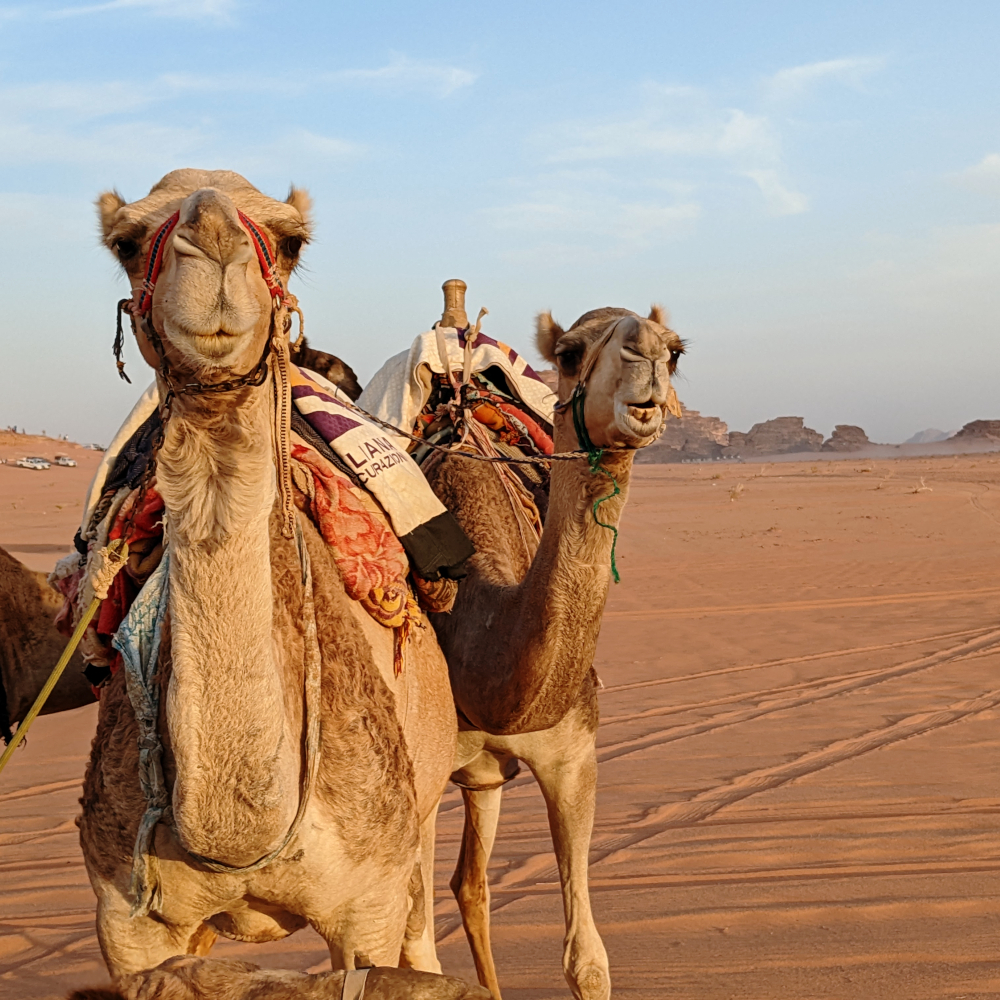
Sunset camels, Wadi Rum, Jordan
Silence.
There is an emptiness in the air that you must hear to believe.
In a world overwhelmed with noise, auditory clutter, and verbal distractions, it is remarkable to find a place where the loudest sound is your own breath.
Simply silence.
Welcome to Wadi Rum.
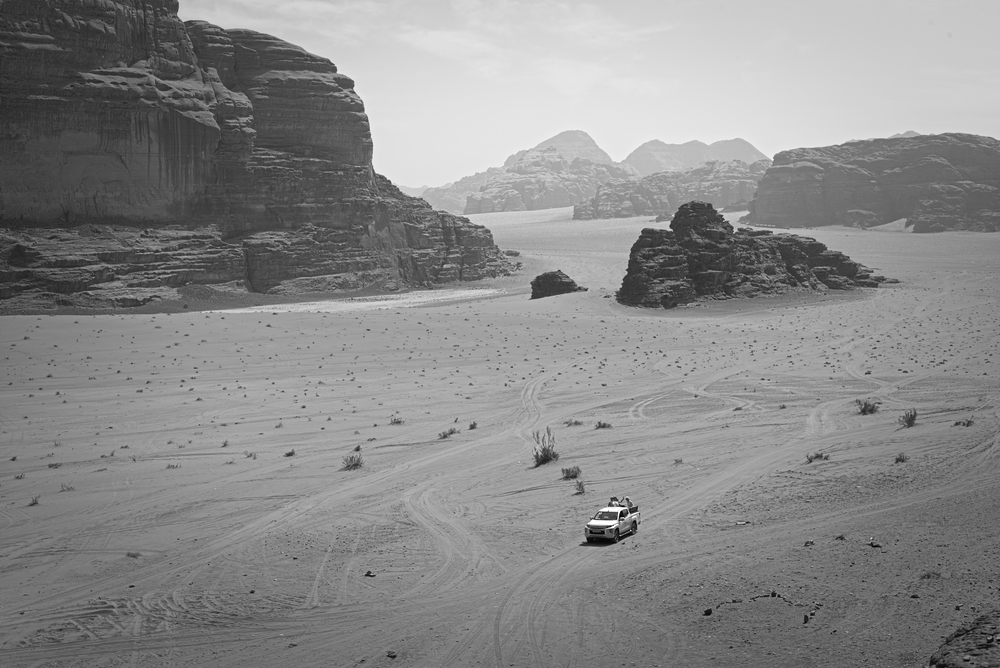
One of the ubiquitous Toyotas of Wadi Rum
A Desert Film Set
This installment of the Peripatetic Historian inaugurates a multi-part series, the Journey through Jordan. Traveling from the Red-Sea-washed southern tip of the country, we will proceed north to Jerash, the ancient Roman city that bakes on a high hill just short of Syria.
The journey begins with our first destination, the great desert of Wadi Rum.
Covering 280 square miles of southern Jordan, Wadi Rum separates the Dead Sea Rift Valley from the beginning of the Arabian Desert. Millions of years ago earthquakes shattered the land and shoved mountains high above the valley floor. Sand-scouring winds and periodic flooding went to work and shaped the ancient upthrusts. The great erosive forces wore away weak stone, carving organic contours and twisted shapes that resemble the wax drippings of melted candles.
The result is a dazzling mixture of flowing lines and unstable planes, a sight that evokes the work of H. R. Giger. If Antoni Gaudi had designed a desert valley, it would have looked like this.
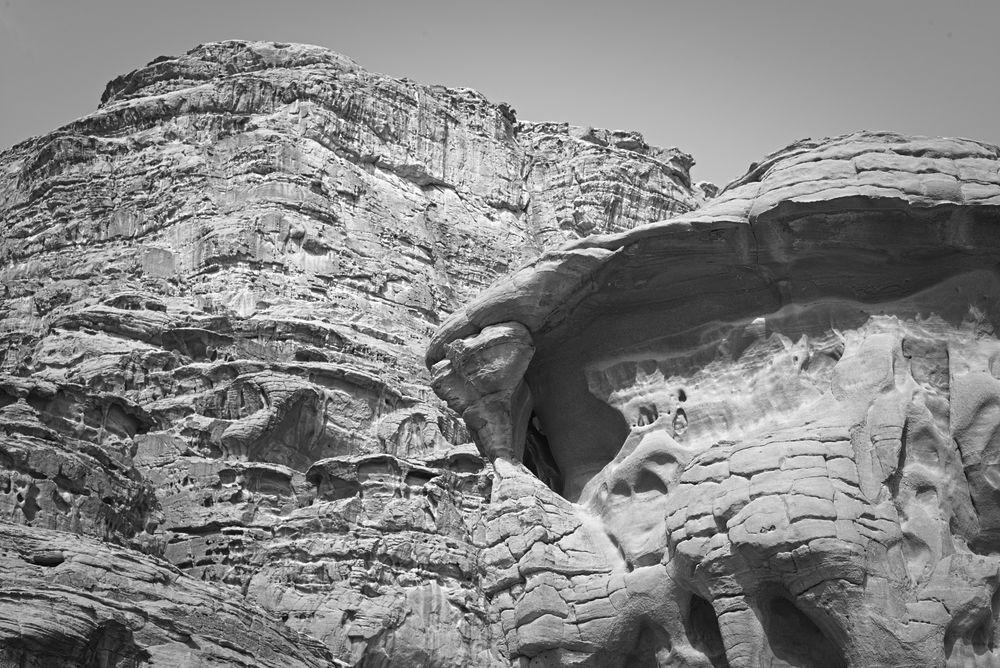
A desert designed by Gaudi
It is haunting. It is beautiful.
And did I mention the silence?
Lawrence of Arabia
You might not have visited Wadi Rum, but it would be remarkable if you had never seen it. Pick any recent movie with a desert scene, and you are probably looking at this place. Wadi Rum, “the Valley of Sand,” is a favorite outdoor set for filmmakers. In recent years, The Martian and Dune, were both filmed here. The red sandstone desert in one of the world’s largest movie sets.
Hollywood’s infatuation with this land began in 1962 when Lawrence of Arabia was filmed here. Based on Thomas E. Lawrence’s Seven Pillars of Wisdom, the movie told the tale of the British soldier’s experiences during World War I, leading the Bedouin tribes of Wadi Rum against the forces of the Ottoman Empire.
Touring the Desert
We rode north in a taxi from the seaside town of Aqaba, and reached Wadi Rum before ten. Mary had booked us into the “Star Wars Camp”—can you guess the name of another movie that has been filmed here?—and we unloaded our baggage in a small cabin whose picture window framed a view of sand and wind-rounded mountains.
The cabins were arranged around a central, open-air courtyard. A small fire smoked near the kitchen and a large kettle stood on a stone slab, nestled near the slow-burning wood. “That tea is always available,” explained our host. “Twenty-four hours a day, whenever you want it.”
We had little time for tea. After a quick slurp of the sweet brew, we clambered into the back of a Toyota pickup and set off for the eastern tour—a six hour ride through the desert. We bumped along the tire-etched ruts that mark the main routes through the red sand valleys. I imagine winter’s winds will efface the temporary witness of our passage.
The first big highlight of out tour was the ruins of T. E. Lawrence’s home. A broken wall of squared-off stones leaned against a rock abutment. This is where Lawrence allegedly lived during the two years he spent leading the Bedouin in this desert. As with many claims made in this part of the world, not all scholars believe he lived here. I bring this up only to be complete.
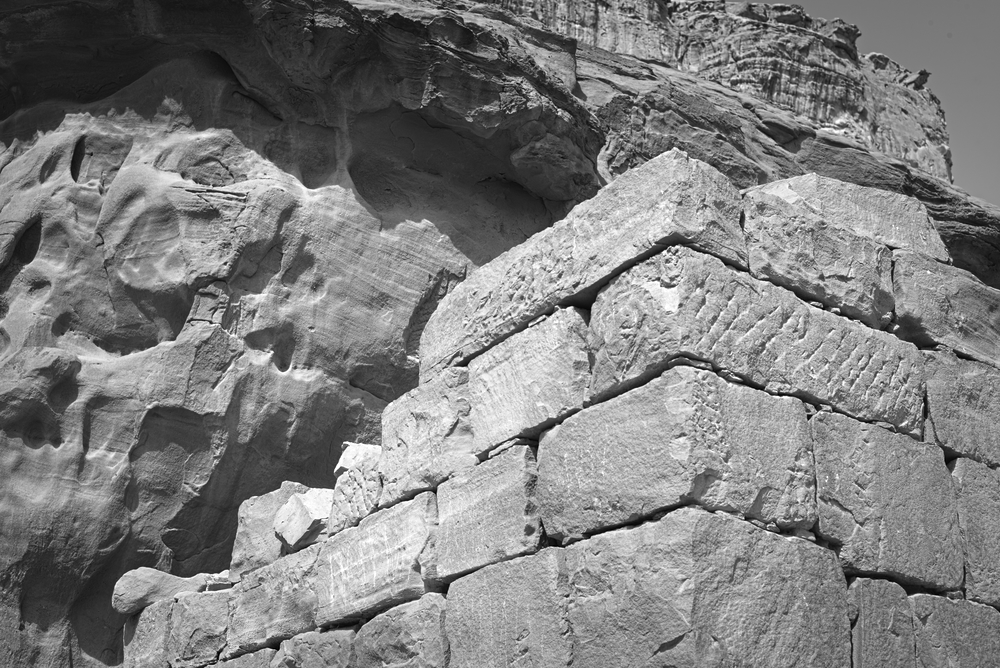
Ruined wall of T. E. Lawrence’s house
Further west we encountered one of the Wadi’s great stone bridges, created when erosive forces etched away softer rock, leaving only this tougher, free-standing arch.
“You can climb up and stand on the bridge,” said our guide. “Or not.”
We chose not. I contented myself with snapping pictures of the bridge and the younger tourists who scaled the cliff to pose on top.
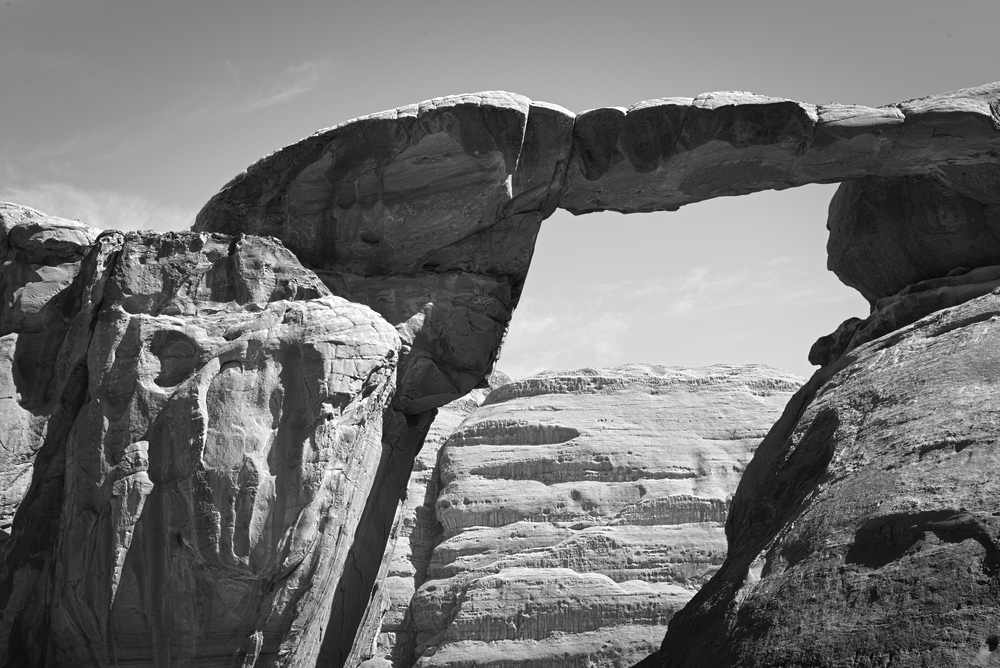
Wadi Rum stone bridge
After a few hours in the Toyota we enjoyed a vegetarian meal cooked over an open fire, and as the day’s tour approached its end, we arrived at a short canyon which contained another Lawrence relic: a carving in the sandstone of the great man’s face.
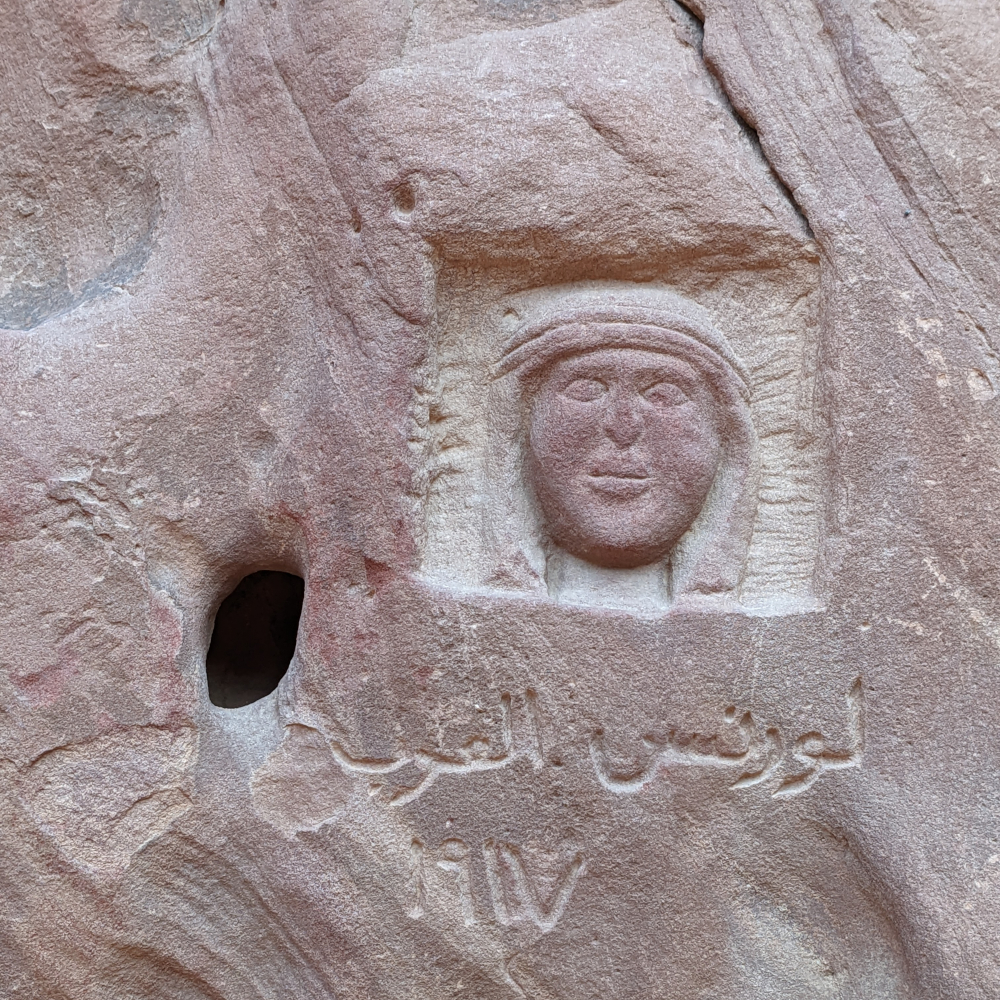
Lawrence of Arabia, in stone
Camels at Sunset
Our tour took six hours and we were a trifle fatigued by the end of it. Although a rest seemed in order, our enthusiasm had compelled us to sign up for the “Sunset Camel Ride.”
How bad could it be? I thought, as we sauntered out the main gate of the Star Wars Camp to meet our steeds. Probably a quick circle around the sandy forecourt and then we’ll be finished.
Wrong.
Our driver led seven camels, roped together, nose to tail. The mounts knelt in the sand, cropping on the odd bush or working over previously digested material. I clambered into the wooden saddle of the camel that had been selected for me.
At our leader’s command, my camel lifted its haunches off the ground (nearly throwing me over its neck) and then pushed off with its forelegs.
Camels are tall. I was a good six feet off the ground. I gripped the small saddle post, a piece of wood the size of a toilet paper tube that serves as the equivalent of a saddle horn. Our caravan lurched into motion. Mary rode the camel behind me, which had an annoying habit of pushing forward and crowding my mount.
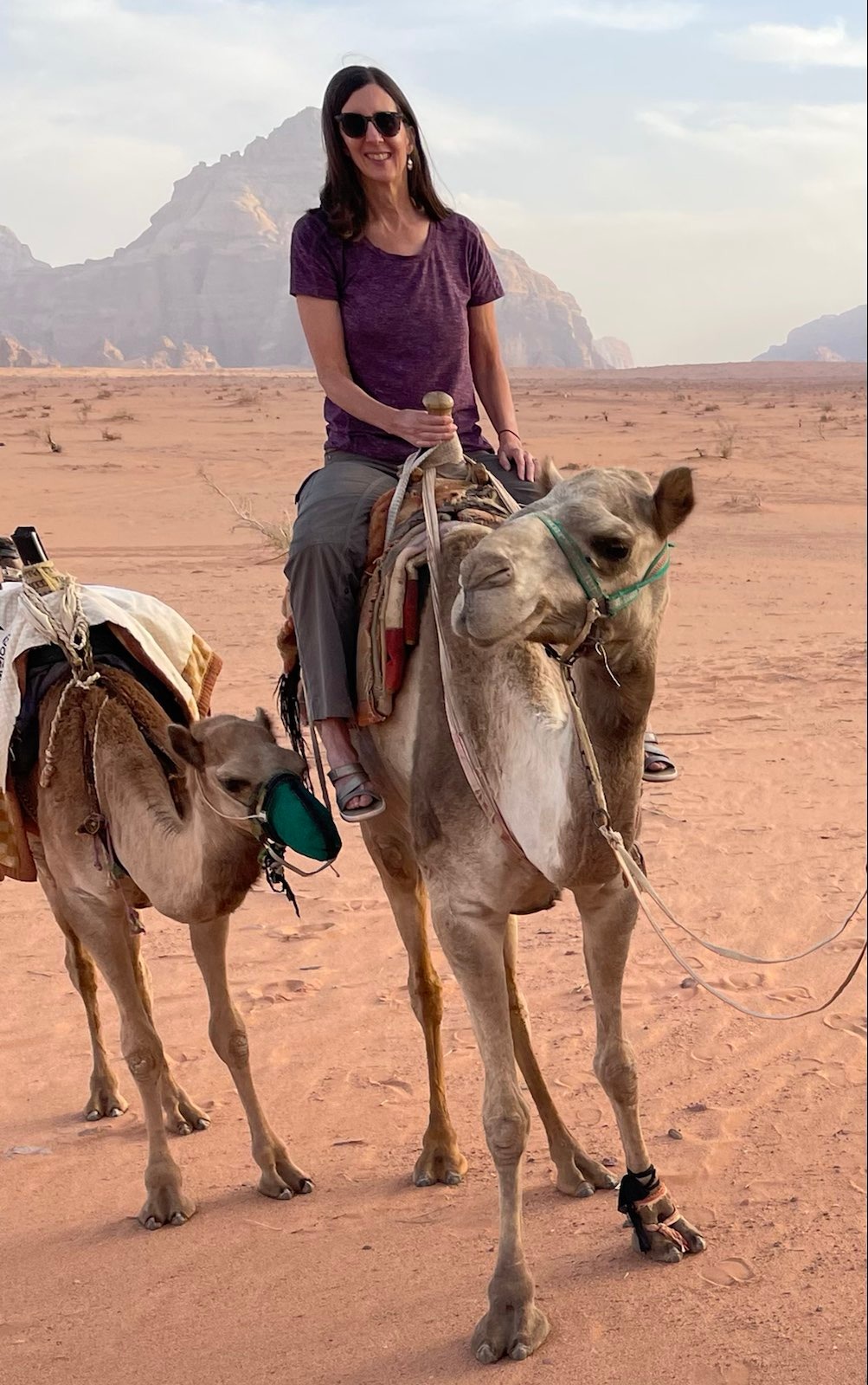
Mary of Arabia
Off we sauntered, heading for the open desert. I always heard that camels offered a smooth ride, but mine swayed fore and aft. I clung to my grip, rocked back and forth, and wished for stirrups so that I might have a little leg purchase.
I found myself agreeing with T. E. Lawrence who wrote, “It was easy to sit on a camel’s back without falling off, but very difficult to understand and get the best out of her so as to do long journeys without fatiguing either rider or beast.”
Imitating our driver, I adopted the Bedouin technique for sitting a camel. You push your legs straight out before you, bend the the right leg over the top of the camel’s neck, and then slide your heel beneath your left leg. Your legs should look like the number “4”, wrapped around the front of the saddle.
It works, although it is a hard position to maintain for a lengthy period of time.
And we had to. Our camel tour stretched for nearly two hours. We rode out into the middle of a sandy flat plain, aiming to secure a good view of the sunset. Hundreds of other tourists—conveyed in pickup trucks—were also out there, waiting to celebrate day’s end. I only saw one other camel caravan.
It was quite an experience. I came away from my trip with a new fondness for the dromedaries. Our animals were very well behaved and they had incredibly expressive faces. They looked slightly bewildered by nearly everything—apart from the desiccated thorn bushes, which they took bites of whenever one was close.

Enjoying a tasty thorn bush
The sun set and our camel train reversed course, returning to the Star Wars Camp. As we rode through the lengthening twilight, I reflected upon the day’s experiences in Wadi Rum. According to the Chinese Zodiac, I am a Water Tiger. I’ve always thought that meant I lurk in wet places and spring suddenly upon the unwary. If I placed any stock in astrology, I would use that identification to explain my deep attraction for the Oregon Coast and Venice. I have a cosmically-preordained need to be around open water.
Acknowledging my fundamental need for water, it is clear that I could never live permanently in a place like Wadi Rum. But short visits are wonderful. I enjoyed our stay between sand and stars, and would happily return for another sojourn in the land of the great silence.
If you are enjoying this series, why not subscribe to Richard's monthly newsletter, What's New in Old News? The Peripatetic Historian is on the road, roaming the world and compiling fresh adventures. Don't miss out. Click here to join the legions of above-average readers who have already subscribed.